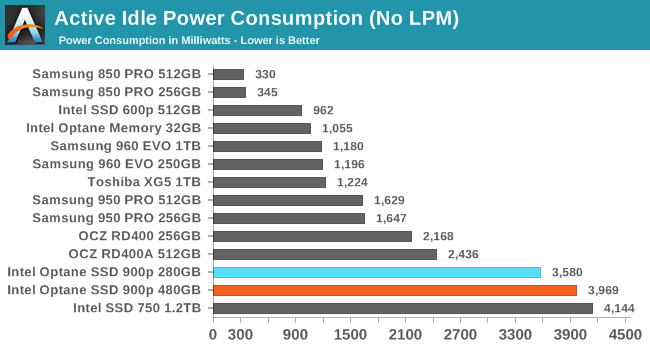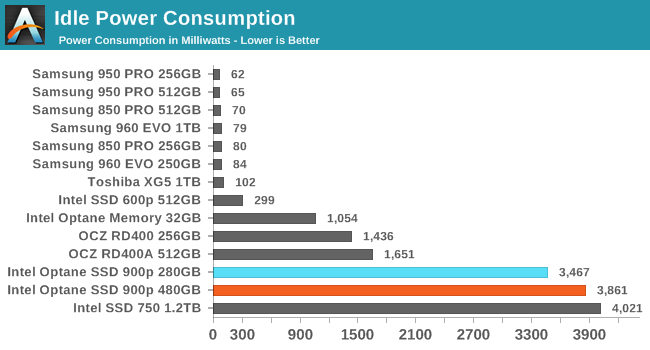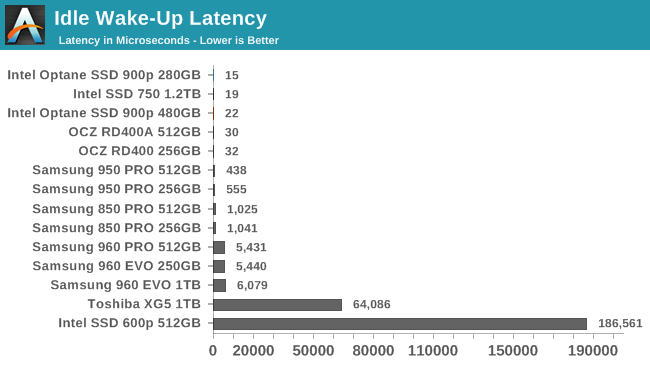The Intel Optane SSD 900p 480GB Review: Diving Deeper Into 3D XPoint
by Billy Tallis on December 15, 2017 12:15 PM ESTPower Management
Real-world client storage workloads leave SSDs idle most of the time, so the active power measurements presented earlier in this review only account for a small part of what determines a drive's suitability for battery-powered use. Especially under light use, the power efficiency of a SSD is determined mostly be how well it can save power when idle.
SATA SSDs are tested with SATA link power management disabled to measure their active idle power draw, and with it enabled for the deeper idle power consumption score and the idle wake-up latency test. Our testbed, like any ordinary desktop system, cannot trigger the deepest DevSleep idle state.
Idle power management for NVMe SSDs is far more complicated than for SATA SSDs. NVMe SSDs can support several different idle power states, and through the Autonomous Power State Transition (APST) feature the operating system can set a drive's policy for when to drop down to a lower power state. There is typically a tradeoff in that lower-power states take longer to enter and wake up from, so the choice about what power states to use may differ for desktop and notebooks.
We report two idle power measurements. Active idle is representative of a typical desktop, where none of the advanced PCIe link or NVMe power saving features are enabled and the drive is immediately ready to process new commands. The idle power consumption metric is measured with PCIe Active State Power Management L1.2 state enabled and NVMe APST enabled (when supported).


(idle power)

(idle wake-up)










69 Comments
View All Comments
nathanddrews - Friday, December 15, 2017 - link
Is there any indication that performance would degrade with a lesser CPU or improve with a faster CPU? Just curious if we should expect CPU bottlenecks from these hyper-speed SSDs.Billy Tallis - Friday, December 15, 2017 - link
Yes, CPU speed can definitely affect latency and consistency and maximum achievable IOPS. Some of those limits were hit with the P4800X testing on a server with lower per-core performance than this consumer testbed.At the moment, my inclination is to leave the consumer test suite single-threaded, because consumer workloads don't actually hit the queue depths necessary to go beyond the I/O capabilities of a single CPU core. I don't care too much if the high QD range on some of the graphs doesn't quite reach the theoretical limit of the drive, because that's not the part of the graph we should be paying attention to. (For consumer drives.)
At low queue depths, interrupt servicing latency can be helped a bit by a faster CPU. But for most consumers, switching from Windows to Linux will do a lot more to help reduce their storage latency. And saving a few more microseconds only matters on Optane; mainstream products won't be this fast for quite a while.
ddrіver - Friday, December 15, 2017 - link
I think I'll have to reevaluate my position on Optane. Seems like a solid product. Guess I misread the signs.ddriver - Friday, December 15, 2017 - link
How can you tell a fake "ddriver" apart? Well, the real one would never mislabel the product hypetane ;)It is what it is, and still nowhere nearly "1000x" better as intel claimed. It has its niche strengths, but those offer no tangible benefit to 99.9999% of the consumers out there. I don't recall ever claiming that it will suck, my claim has always been that it will epically fail to live up to the hype, which testing thoroughly confirms. It is not even 10% of "1000x better". So hypetane it is.
SLC flash can easily match and even bet it in most performance metrics. Unfortunately the industry is not even trying, even mlc is now considered "ultra high end enterprise". Which is understandable, as the workloads that could actually benefit from higher performance are very few and far in between, and for 99% of them using ram is the more applicable and still tremendously better performing solution.
It is definitely not a bad product on its own. And I would not refer to it as "hypetane" if only intel hadn't shamelessly lied about it on such a preposterous scale.
tuxRoller - Friday, December 15, 2017 - link
Interface speeds≠ media speedsWhen will you learn?
Also, still need a reference for those SLC numbers.
LordanSS - Saturday, December 16, 2017 - link
Indeed, Interface speeds are not "media" speeds. I never expected it to work according to Intel's "1000x" claims, but was hoping for a more in-line 20x better from what we currently have, considering first generation product and all.And it doesn't even do that. Sorry, for this one time, I am (partially) siding with ddriver.
lmcd - Saturday, December 16, 2017 - link
20X better overall is entirely unrealistic. Certain attributes are 20X better. That is all you can really expect when so many things (form factor, power usage, interface protocols, physical interface, etc) are retained from the previous generation.LordanSS - Sunday, December 17, 2017 - link
20x is 2% (TWO PERCENT) of what Intel claimed when they disclosed XPoint. It's not realistic?Intel shoul have kept their mouth shut back then, just like Micron has done so until now. If they can't even do 2% of what they claimed, they're the unrealistic ones.
tuxRoller - Sunday, December 17, 2017 - link
Were those claims that Intel made in reference to xpoint the tech, or optane the first gen product?tuxRoller - Saturday, December 16, 2017 - link
I'm not sure why you are quoting media, but you are absolutely welcome to be disappointed.You'll notice I don't care whether anyone thinks Intel over hyped their product only that we still don't know what the actual xpoint (the media, or "tread + xfer + Misc" times, as Handy refers to it) response times look like.
If AT doesn't allow the below link, search for "xpoint presence in slow lane explained" on the register, or Google "Why XPoint SSDs won't meet original speed claims: A guide"
https://www.theregister.co.uk/2016/09/29/xpoint_pr...